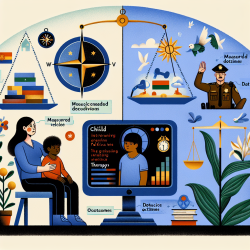Introduction
In the realm of speech-language pathology and child therapy, the importance of utilizing data-driven insights cannot be overstated. One intriguing area of study that offers valuable insights is the research on supportive interventions by Chinese police in domestic violence cases. This research, while primarily focused on policing, offers broader implications for practitioners working with children, especially in therapeutic settings.
Key Findings from the Research
The study titled "Supportive Interventions of Chinese Police in Domestic Violence: Do Officer Knowledge and Training Matter?" explores the relationship between police officers' knowledge and training regarding domestic violence (DV) laws and their willingness to provide supportive services. Key findings from the study include:
- More than half of the officers referred intimate partner violence survivors to shelters and assisted victims in filing protection orders.
- Counseling practices varied across provinces and between male and female officers.
- Agency training and the use of body-worn cameras (BWC) were positively associated with non-coercive and supportive approaches.
- Knowledge of the DV Act, male dominance score, and gender equality score did not predict the use of supportive approaches.
- Demographic characteristics, including police rank, length of service, and province of employment, influenced the utilization of non-coercive and supportive approaches.
Implications for Child Therapy Practitioners
While the study focuses on police interventions, its findings have significant implications for practitioners in child therapy. Here are some key takeaways:
1. Importance of Training
Just as police officers benefit from training to enhance their supportive interventions, child therapy practitioners can improve their outcomes through continuous professional development. Training in recognizing signs of DV and understanding its impact on children can empower therapists to provide more effective support.
2. Use of Technology
The positive association between the use of BWCs and supportive interventions highlights the potential of technology in therapeutic settings. For instance, teletherapy platforms like those offered by TinyEYE can facilitate access to therapy for children in remote areas or those who feel safer communicating from home.
3. Tailored Interventions
The study's findings on regional variations in police support underscore the need for tailored interventions in child therapy. Practitioners should consider the cultural and regional contexts of their clients to provide personalized and effective therapy.
4. Holistic Approach
Just as police officers employ a range of supportive measures, child therapists should adopt a holistic approach that includes emotional, psychological, and social support. This can involve collaborating with other professionals, such as social workers and educators, to address the multifaceted needs of children affected by DV.
Encouraging Further Research
The study highlights the complexities and challenges faced by police officers in providing supportive interventions. Similarly, child therapy practitioners are encouraged to engage in further research to explore innovative strategies and interventions that can enhance therapy outcomes for children affected by DV.
Conclusion
In conclusion, the research on supportive interventions by Chinese police in DV cases offers valuable insights for child therapy practitioners. By focusing on training, leveraging technology, tailoring interventions, and adopting a holistic approach, practitioners can enhance their therapeutic outcomes and provide better support for children. For those interested in delving deeper into the research, the original paper can be accessed through this link: Supportive Interventions of Chinese Police in Domestic Violence: Do Officer Knowledge and Training Matter?










